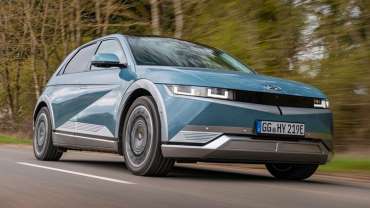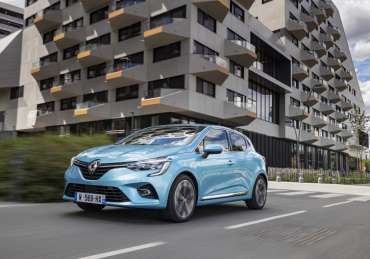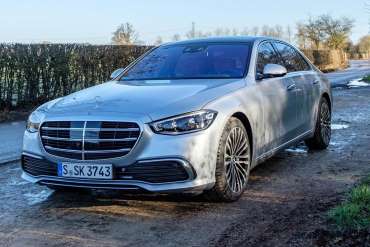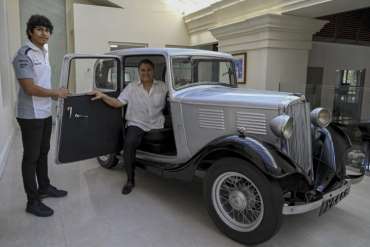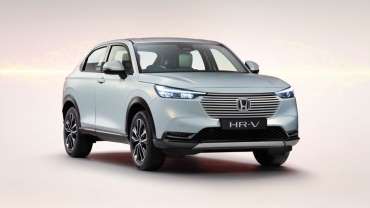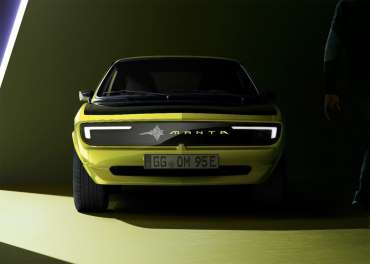
Worldcarblog.com
The Lamborghini Squadra Corse announces a new model (VIDEO)
Last year, Lamborghini’s Squadra Corsa racing department introduced the SC20, a custom-designed speedster with a 6.5-liter V12 that can be found under the hood of the Avendator SVJ Roadster. The racing supercar is capable of producing 770 hp (566 kW) and 719 Nm of torque, and now Lamborghini’s racing division is working on its next creation.
Although the details of the new mysterious Squadre Corsa project are still a secret, a short video announcement suggests that it is a track-only version of the Huracan Evo. As Jutarnji.hr reports, Lamborghini promises that its "latest motorsport car will offer an unprecedented experience".
The rear end is dominated by a huge spoiler and diffuser, and an opening is visible on the roof that optimizes the air flow. The front and rear lights have been redesigned, and the video allows us to hear the sound of a natural V10 engine as well.
Given that the Squadra Corse has already worked on the road-homologated Huracan WTO, we don’t expect this version to be legal for the trip. Instead, this is most likely Lamborghini’s new race car, but it remains unclear in which class it will compete.
Currently, the Squadra Corse competes with the Huracan in international races in the GT3 class and the Super Trofeo series. In addition, it should be noted that Lamborghini recently celebrated the production of the 400th Huracan GT3, so this mysterious project could represent a turning point.
If the new Huracan racer is not limited by motorsport regulations, it should produce significantly more horsepower than the road version of the Huracan Evo, which delivers 640 hp (471 kW) and 600 Nm of torque on the road.
We won’t have to wait long for all the information about the Squadre Corsa project, given that Lamborghini has promised that the new supercar will “race” on the tracks soon.
{vembed Y=KGf3vTZRWyU}
Hyundai Ioniq 5 prototype (2021) review: an electric showstopper
It's clear that Hyundai's mantra must be 'speak softly and carry a big stick.' It just must be. Being among quiet pioneers of family-friendly electric cars already with the original Ioniq and Kona, the brand is about to smack us across the chops with a whole new range of EVs under the Ioniq sub-brand, starting with this: the Ioniq 5.
We've driven a near-finished prototype of for our first whack. Has Hyundai beaten VW at its new game?
What a looker!
Hyundai says the look has been inspired by the Pony Coupe of the 70s but, unlike so many car brands looking to its past to guide its future, design-wise, this is no slavish pastiche. It's an eye-popping piece of design, shaped as a family hatch, with pixelated lighting front and rear and super-crisp lines.
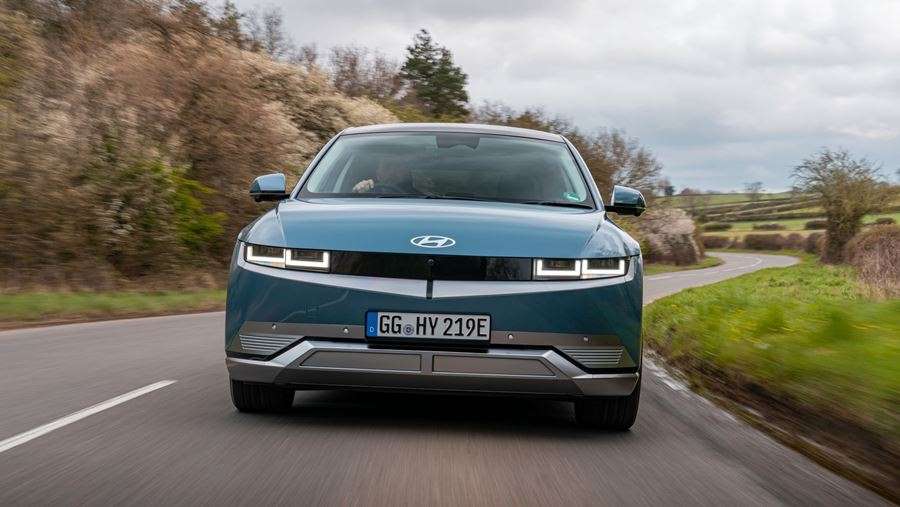
Interestingly, though, the Ioniq 5's dimensions are much larger than you think. This design masterstroke actually hides the car's size: it's actually longer than a VW ID.4 both physically and in terms of its wheelbase and about 40mm taller than a Jaguar i-Pace.
Speaking of the i-Pace and ID range, we conveniently managed to park next to Jag's EV and an ID.3 – both look instantly dated compared to this.
Inside, the cockpit takes full advantage of the e-GMP platform that lies underneath. A flat floor means no fixed centre tunnel, with a movable centre console that provides cupholders, cubbies and a wireless phone charger. You're also greeted by thick padded seats, two massive screens and a kitsch two-spoke wheel like a Honda E.
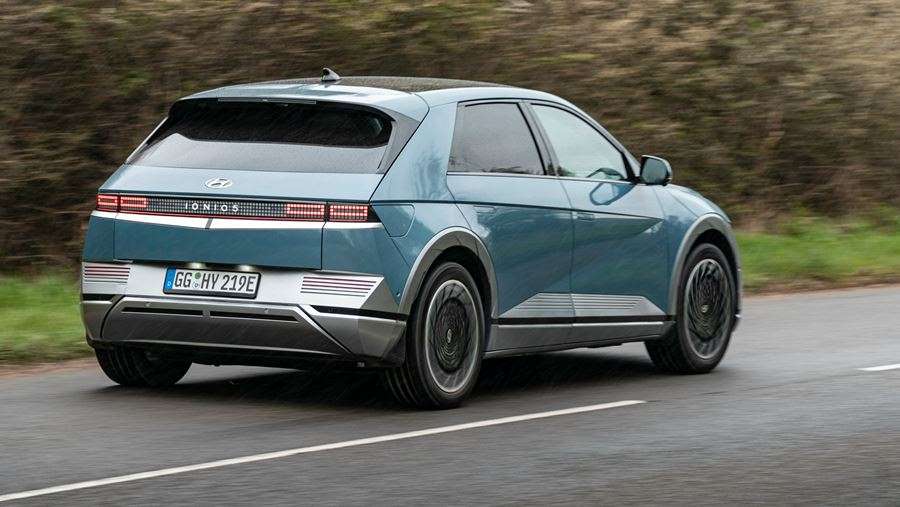
But Hyundai hasn't gone tech overload in here like Mercedes, or ultra-minimalist like a Tesla Model 3 – there's a balance between large, useful screens, touch panels and physical switchgear and solid materials on all your regular touch points. The shift stalk, for example, is on the steering column, with a chunky twist action and the door inlays – complete with eco-friendly paper inserts – all feel solid with a tactile thunk when you pull the door handles.
Space is impressive, too. The cabin itself feels huge once you're inside, with loads of room for rear passengers, too. The rear bench can slide forward and back and, even with a 6ft 2in driver like myself at the wheel, there's tonnes of legroom. The boot, however, is rather shallow, but has depth end to end, and properly usable width. You don't even need to store your cables here – there's a handy storage box under the bonnet for that.
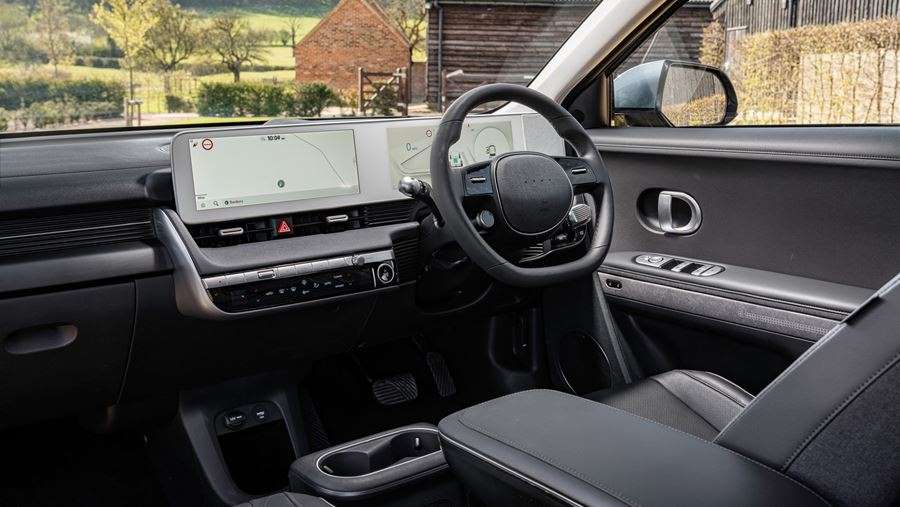
Any clever technology on the Ioniq 5?
The platform, for a start. The new e-GMP platform will underpin every new Ioniq sub-brand model from Hyundai along with Kia's new EV range starting with the EV6. Rear- and all-wheel drive powertrains are offered, with the Ioniq 5 giving you a choice of a standard range 58kWh or long-range 72.6kWh battery packs. And, along with a three-pin plug socket in the car, there's 'vehicle to load' – the ability to use the car as a rolling power bank, allowing you to plug in (via an adaptor on the charging port plug) almost anything externally, like a lawn mower, e-scooter or even another EV.
Hyundai's electric car plans explained
It's also as clever as a Taycan, allowing for both 400 or 800-volt charging, meaning (on the fastest available 350kW chargers, of course) the ability to zap from 10 to 80 per cent charge in just 18 minutes. Hyundai claims 296 miles in the Ioniq's thriftiest setting (larger battery, rear-wheel drive), but you can expect an ID.3 rivalling 260-plus from the all-wheel drive variant.
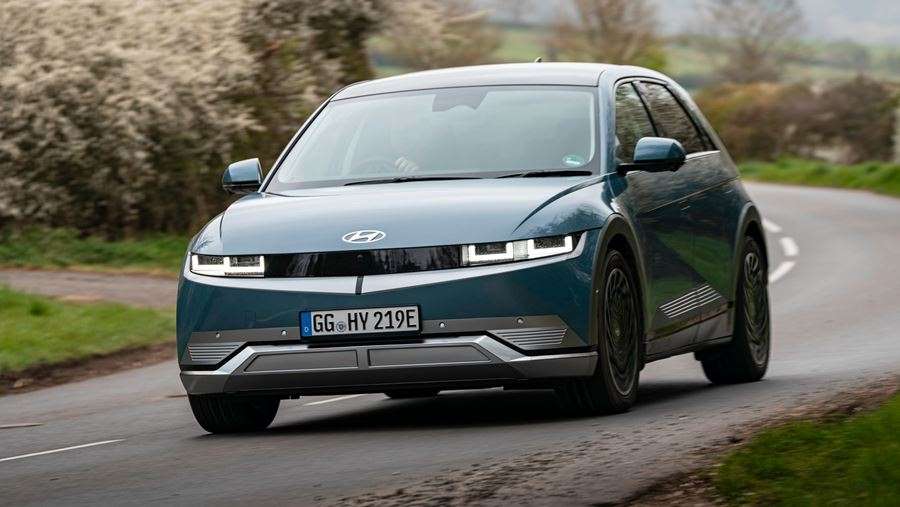
Live in a sunny area? Of course you don't, not in the UK at least, but you can spec a solar cell roof (after the Ioniq's initial launch) that aids the batteries: 'The solar roof has a charging capacity of 205W, and in an environment that is sunny we did some experiments and found that it could add 1200 miles of range per year, or about three miles per day,' Ioniq 5 project manager, Askin Kahraman, told us, 'The roof will also help the 12V battery so the car doesn't discharge completely.'
Then there's all the available tech on board. Along with Level 2.5 semi-autonomous driving tech, you can have Hyundai's Blind Spot View Monitor (that shows you the view of the door mirror camera when you flick the indicator), an augmented-reality head-up display and front seats that recline with leg supports like a living room La-Z-Boy.
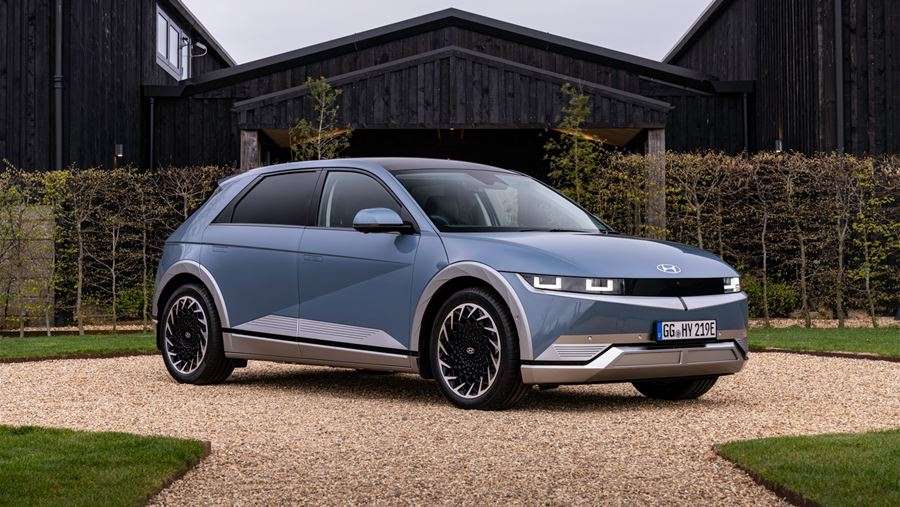
Hyundai's Blind Spot View Monitor: does it work?
Our car was fully trimmed with every frippery you could ask for, implying that it was one of the limited-run 'Project 45' versions, at £48k. On top of all the tech that gives you, it also means your Ioniq 5 comes with the bigger 72.6kWh battery and all-wheel drive. As for lower trims, we expect it to follow the same trim structure as Hyundai's other models: SE Connect, Premium and Ultimate, with the cheapest models circling the £39,000 mark.
Let's drive it!
Walk on up to it and flush doorhandles pop out, ready for the drive ahead. Given the front seat's reclining nature, the whole seat angles backward if you want thigh support – rather than just the front end of the base – and the wheel adjusts for plentiful reach and rake.
Once you're rolling, the 5's interesting details don't instantly reveal themselves – it feels entirely standard fare for a family EV – quiet, inoffensive and smooth when you're nipping around town. And properly quick, just like an EV with so much torque should be; Eco mode dulls the throttle while, at the other end of the drive mode scale, the dials glare red in Sport and the throttle response is incredible. And this simply won't be the most powerful version of the E-GMP platform, either. Kia, for example, has already shown off a supercar-baiting EV6 GT, so it's not beyond the realms of possibility that Hyundai could make an Ioniq N.
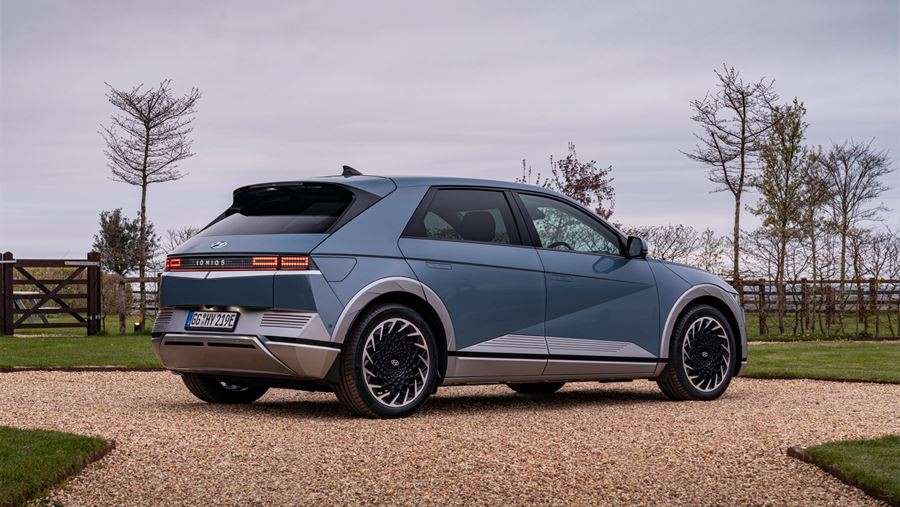
Then you start to notice the finer points after the miles roll on.
The steering, for example, is live-wire alert and well-weighted – no dead-spots off-centre and tremendously fluid when you wind the lock off after a turn. The turning circle is tight, too; not London Taxi or Honda E tight, but not far off. Then there's the brakes. It's almost an expectation for an electric car to have a soggy brake pedal and inconsistent feel when you apply some pressure due to regenerative braking (of which Hyundai has four steps, plus a one-pedal mode), but not here. Plenty of solid, accurate feel regardless of regeneration level.
You can really have fun with this car on a back road – something not often said this side of a Taycan. Adding up the whumping torque, sharp steering and feelsome brakes is already plenty good enough, but there's real balance to the chassis, too. This doesn't feel leaden or recalcitrant when you want some zippy thrills going the fun way home. Yes, there's a touch of body roll, but the way the suspension handles the Ioniq's weight is really something to be commended – it's a hoot.
We even got some time on the motorway. Hyundai told us that not all of the production-spec soundproofing is on this prototype but, if that's the case, I've driven plenty of family in-production family cars (including those of premium manufacturers like Audi) that riding on 20-inch wheels that have worse NVH refinement. Tyre noise is well within an acceptable level and wind noise is minor. Couple this with balanced ride quality – not too jittery, but not water bed wallowy either – and it's a very promising position to be in.
First impressions: Hyundai Ioniq 5
What an impressive machine. We can't wait to try a production-spec one but, even in this prototype, the Ioniq 5 brings such a breadth of abilities that other EVs can only dream of. Show-stopping looks, a thoroughly usable and appealing interior, and sharp dynamics that are rare to find in a heavy family EV.
Convinced by VW's ID.3? Try one of these first.
(carmagazine.co.uk)
New era: Renault will no longer develop diesel engines
Apart from the fact that the French manufacturer will no longer invest in the development of new diesels, it also announced that it limits the maximum speed to 180 km / h for new models.
At the recent Renault Group shareholders' meeting in Paris, CEO Luca de Meo also announced the maximum speed limit for all future models coming from this company.
"Speed on all our cars will be limited to 180 km / h," said de Meo, who has led Renault since last year.
He also announced that the first model equipped with a new electronic device that limits the maximum speed will be a serial version of the Renault Mégane eVision concept, ie the Renault Mégane E model announced for the next year, 2022. Moreover, the blockade on it will be even more extreme, ie it will be set at 160 km / h.
In addition to the device that will block the maximum speed (and will not be able to unlock), the electric SUV will be the first Renault equipped with another limiting system - automatic speed control called Safety Coach - active speed limiter, which will comply with speed limits and geolocation data, will take into account the road profile, examples of dangerous curves, weather conditions…
De Meo claims that he was led to these moves by statistics according to which speed is still responsible for a third of all traffic accidents with a fatal outcome, so he hopes that the restriction will significantly help increase road safety.
Furthermore, what Renault has developed from diesel engines - it has developed, because it will no longer invest in them, but will improve the current ones to the level as much as possible in terms of environmental standards.
CEO De Meo also confirmed that he will no longer invest money in the development of new generation diesel engines, and whether that means that Renault diesels will not exist in the Euro 7 era remains to be seen. However, seeing how the demand for hybrid and electric cars in Europe exceeds diesel, it will not be a surprise if French models with diesel engines disappear from the market in 2025.
Admittedly, diesel has already been discontinued in many models, and even Dacia has begun rejecting diesels in its latest generation of models in Europe.
Mercedes-Benz S-Class review
Big Mercedes-Benz comes loaded with tech, but feels less weighed-down
Is the Mercedes-Benz S-Class any good?
You bet! Without fail, each new generation of Mercedes-Benz S-Class is tasked with setting new standards of excellence. And in the case of this one, its maker has pulled out all the stops with a car that's designed to be smoother and more serene than ever before.
But even if you're not in the market for a high-priced luxury car, you reall should take notice of this one. Much of the technology that debuts in this car will undoubtedly filter down into more popular cars over the next few years.
The S-Class also needs to be exceptional, as it faces a diverse and incredibly capable set of rivals in the form of the Audi A8, BMW 7 Series, Bentley Flying Spur and the Rolls-Royce Ghost. It also has to battle top-end SUVs, such as the Mercedes-Benz GLS as well as the ever-popular Range Rover.
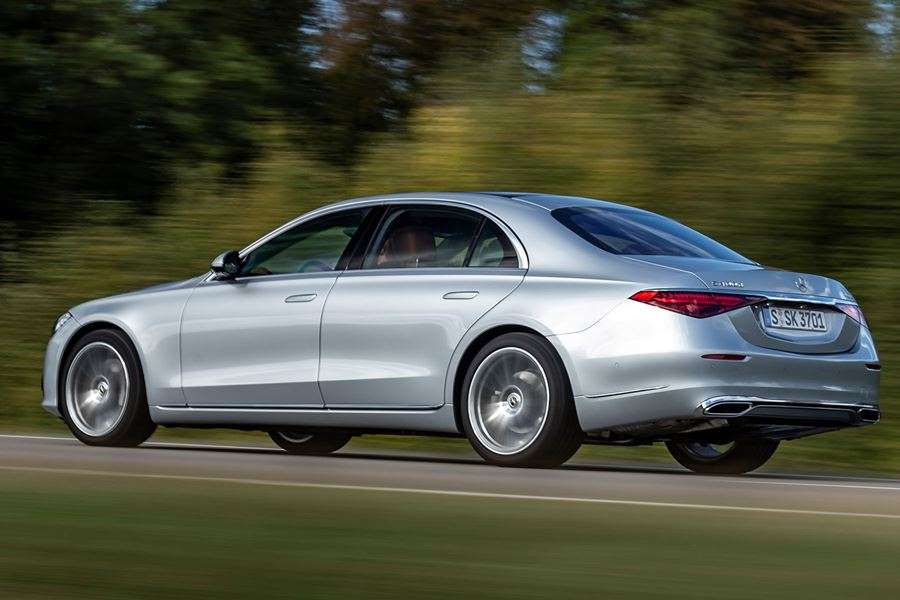
This is ignoring the growing selection of four-door coupes as well (Mercedes’ own offering, the CLS, is based on the E-Class but traditionally delivers the luxury of an S-Class in a sportier, smaller package) and Porsche Panamera. There are many, many vehicles the S-Class needs to outclass to get your attention – and, apologies for the spoiler, but we think it manages it.
What's it like inside?
This is, perhaps, the most welcoming S-Class interior yet, with an almost cosy wrap-around feel and lavish, soft surfaces everywhere. Technology still defines the S-Class' mission to blaze a trail others follow though, and there's a single, large display panel that slopes downward, with a central infotainment touchscreen dominating the overall view up front.
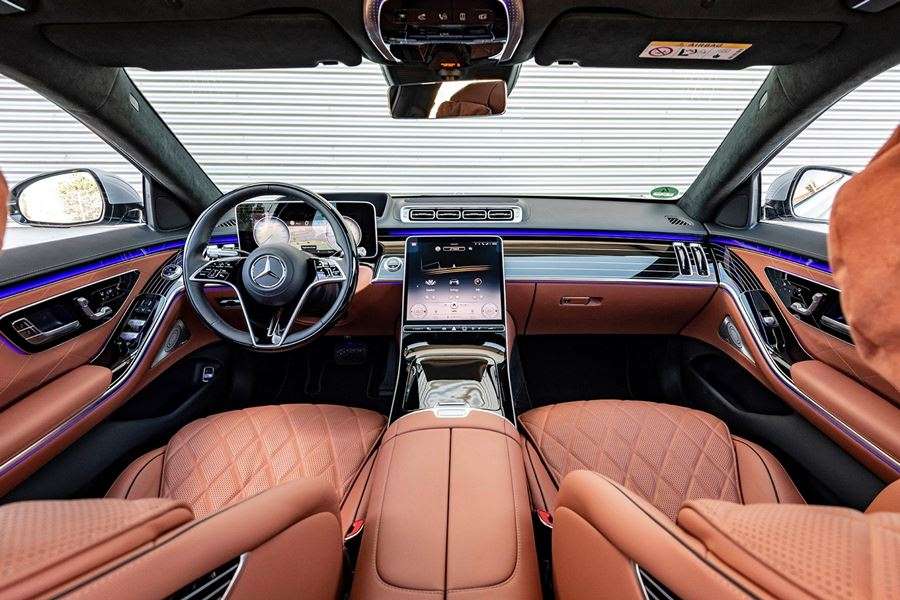
A new air filtration system is included, which can do things like pump perfume into the vents and automatically activate the recirculation setting when you go through a tunnel.
The 12.8-inch control screen is available with haptic feedback and OLED technology, and is easy to read from all angles and interact with as a conseqence. That clean interior design approach extends to the use of an augmented reality head-up display and 3D instruments that can be reduced to a minimal amount of information.
Several different designs can be had for the digital instruments, including a sporty one with red dials, to the classy Exclusive theme that displays white dials and backgrounds.
Mercedes-Benz’s MBUX 'Hey Mercedes' voice assistant has also had an upgrade, allowing for even more natural speech. If someone says they’re tired, one of the car's Energising Comfort programs can be activated, for example. When certain prompts arise, like an incoming call, the ‘Hey Mercedes’ activation phrase is not required – someone can simply say ‘Accept call’ – all in an attempt to simplify using the car's vast array of functions.
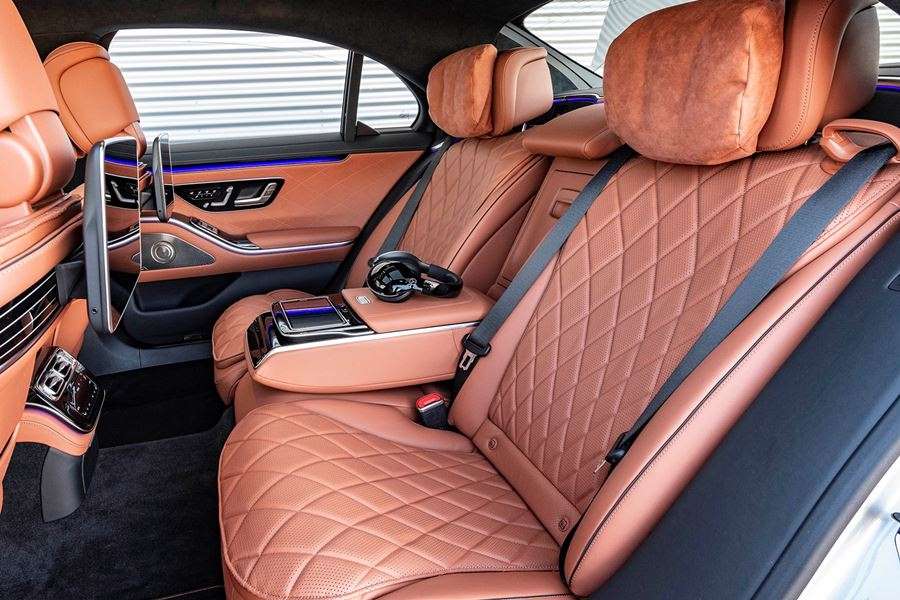
What's it like to drive?
Currently, there are two diesels and one petrol to choose from, all of which use Mercedes-Benz’s latest straight-six engine range. The S 500 petrol also has 48v mild hybrid assistance that helps boost torque and all hit 155mph. We've only driven the S 500 version so far, but it's powerful, smooth and surprisingly economical, given its size.
Unsurprisinly, S-Class majors on comfort – it rides on air suspension that lowers itself automatically at speed while giving a soft ride for passengers. Rear-wheel steering is also available in two versions, with one set-up allowing the rears to turn at up to 10 degrees. Mercedes claims that, four-wheel steering gives an S-Class has a similar turning circle to an A-Class hatch.
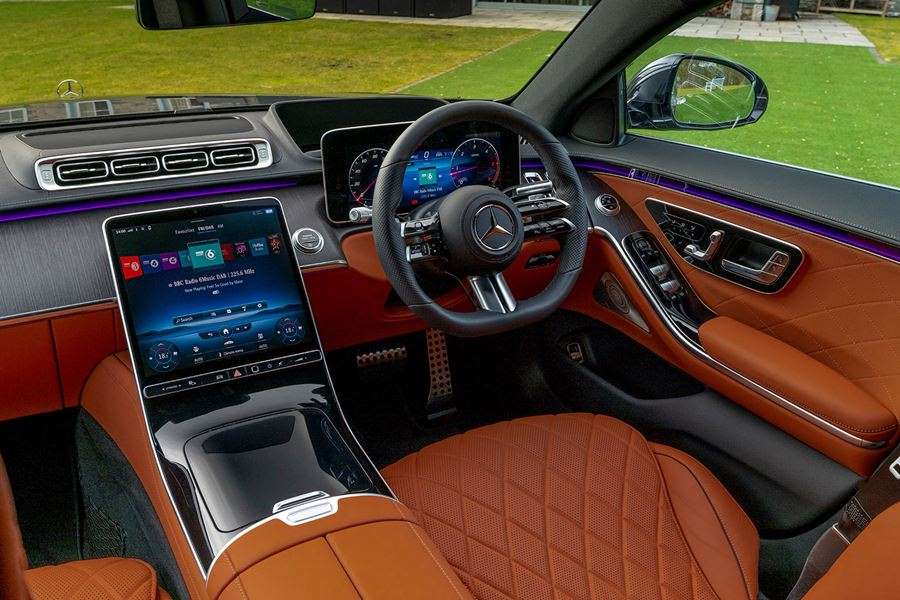
One advanced option is the E-Active Body Control system, which allows the new S-Class to tilt into corners like a Pendolino train. The technology also raises the ride height by 8cm when sensors detect a side impact is imminent, positioning the chassis to take the brunt of the crash via the door sills, rather than the doors themselves.
What models and trims are available?
The diesel line-up comprises of an S 350 d (286hp) and the 330hp S 400 d 4Matic (meaning four-wheel drive), while the petrol is the S 500 4Matic, which boasts a power output of 435hp. More models will follow in the coming months.
There are six trim levels to choose from – AMG Line, AMG Line Premium, Long AMG Line Premium, Long AMG Line Premium Executive, Long AMG Line Premium Plus and Long AMG Line Premium Plus Executive.
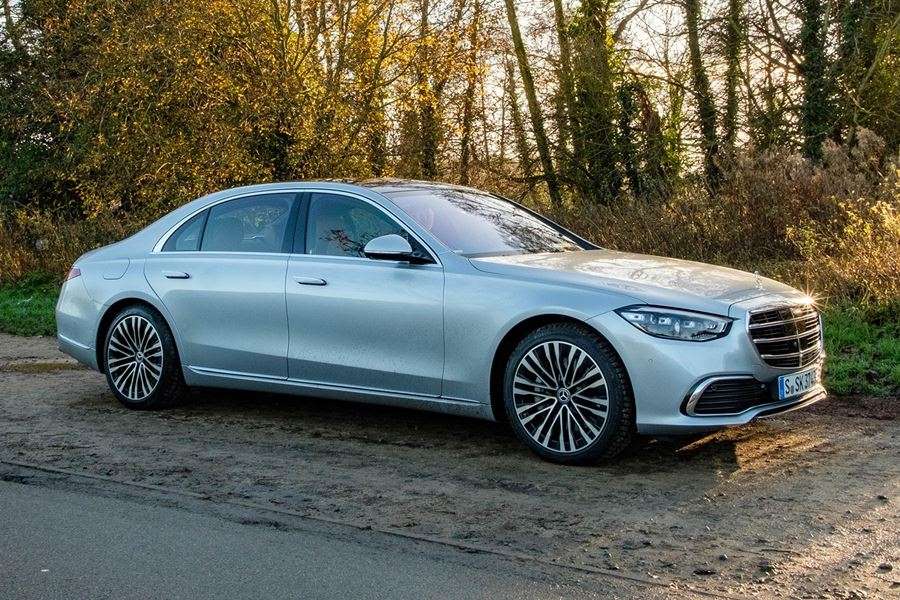
Even the entry-level AMG Line model is well equipped, coming with 19-inch wheels, air suspension with self levelling, keyless-go with seamless door handles, Intelligent LED headlights, parking package with reversing camera and power closing doors and bootlid. Move up the range and start plundering the options list at the sky's your limit.
What else should I know?
You can order an S-Class now, with deliveries set for later in the spring of 2021 – with the diesel S 400 d version offering the fuel consumption, and the S 500 giving the quickest performance, as you'd expect. But on paper, the gap between petrol and diesel has closed considerably. The gamechanger will be the plug-in hybrid S 580e, which is due to go on sale late in 2021.
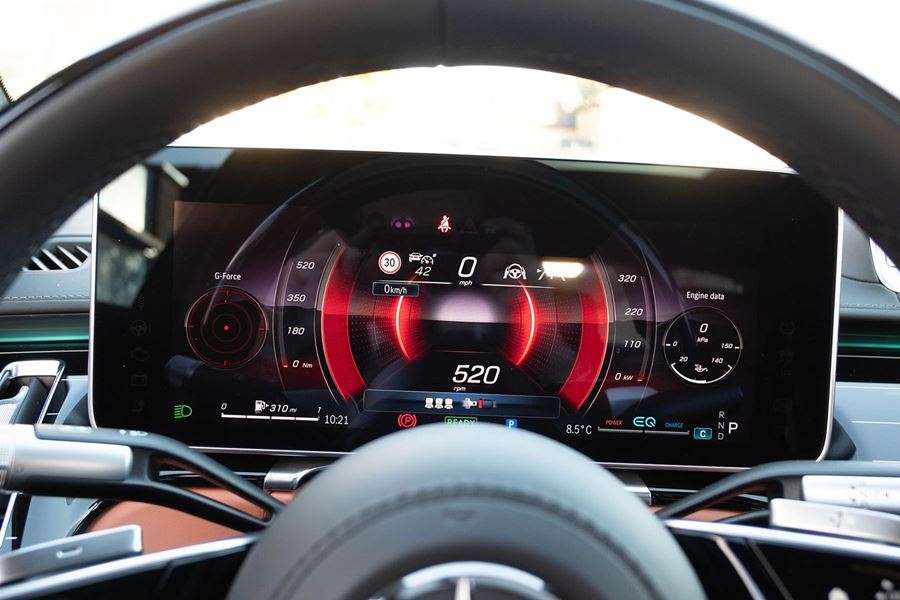
Don't expect your local Mercedes-Benz dealer to be offering discounts any time soon, as it's so new and interest is running high. The number of cars coming to the UK will be limited so as to keep a firm control on supplies. We'll know more about reliability and ease of running as the year unfolds, but we don't expect it to be much different to the last S-Class, which was held in high regard in that respect.
(parkers.co.uk)
Prince Philip's car "star" of the museum - "Standard nine" from 1935.
The nearly 90-year-old car, which once belonged to the recently deceased British Prince Philip, is on display in a museum in Sri Lanka, where it is considered a central exhibit.
The Duke of Edinburgh, who will be buried tomorrow, was a big fan of cars, and he bought the "standard nine" from 1935 for 12 pounds during his stay in the largest city of Sri Lanka, Colombo in 1940, as a member of the British Royal Navy.
"When he returned in the early fifties, he came and looked at the car. He said that he hoped that the brakes were correct because they were not there before, "said Sanjiv Gardiner, who kept the car in his hotel" Gal Face "in Colombo.
Gardiner said Prince Philip admitted that the car was the first vehicle he bought. The Duke of Edinburgh became the patron of the Motor Vehicles Club "Standard".
The Gale Face Hotel is one of the oldest in the former British colony, and the museum is built around a silver-and-black passenger vehicle.
Prince Philip failed to lower the price of the used vehicle, although he managed to pay in two installments within a month.
According to the documents kept in the museum, Prince Philip drove the mentioned car for the first time from Colombo to the naval base in Trikonmalia, which is located 260 kilometers from the largest city of Sri Lanka.
"The car has covered 93,040 kilometers, has been restored several times and can still be driven, but the insurance costs are high, which means that it is no longer used," Gardiner told AFP.
Gardiner's father Cyril bought this car in the early 1950s. He rented a "Cadillac" to the royal family, in which Prince Philip and Queen Elizabeth II rode during the first official visit to Sri Lanka in 1954.
According to Gardiner, the restoration of two cars used by members of the royal family is underway.
Prince Philip, who passed away last week at the age of 100, was a great lover of cars and often drove them himself.
However, in 2019, he handed over his driver's license after a collision that caused his car to overturn and in which two more people were injured.
The coffin in which the Duke of Edinburgh will be buried will be driven to the Windsor Castle tomorrow by a "Land Rover Defender", a vehicle designed by Prince Philip.
Honda HR-V: e:HEV hybrid powertrain details revealed
New Honda HR-V SUV has a fresh look, updated technology and a 129bhp dual-motor hybrid powertrain
The all-new Honda HR-V was revealed earlier this year and now the firm has confirmed further details of the new car’s 129bhp e:HEV hybrid powertrain.
For the third-generation HR-V, Honda has given it a sleeker exterior design, an all-new interior and updated technology onboard. The new car will only be available as a hybrid and is expected to go on sale later this year with a starting price of around £25,000.
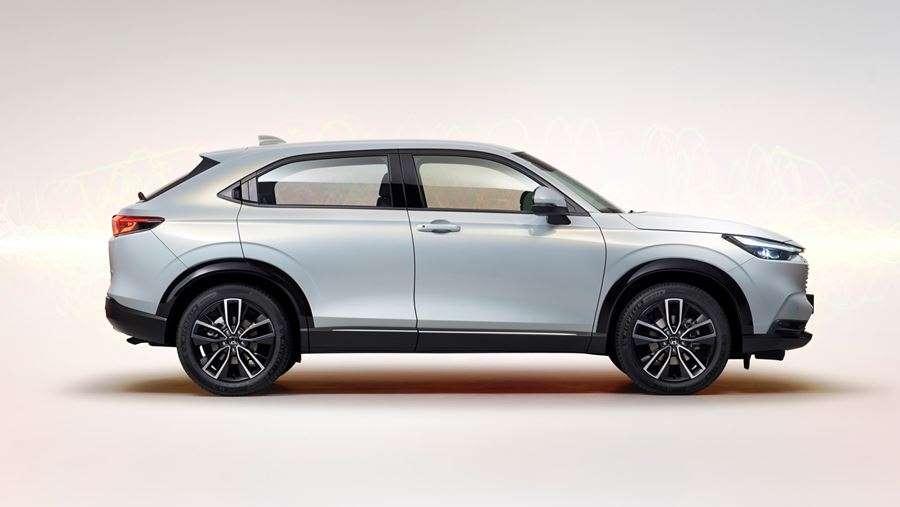
When it arrives, the new HR-V will go head-to-head with small SUV models including the Ford Puma, Renault Captur and Skoda Kamiq.
2021 Honda HR-V hybrid: engine and performance
Honda has announced the latest HR-V will be powered by a 1.5-litre petrol engine mated to two electric motors and a CVT automatic gearbox. This powertrain is similar to the one used in the current Jazz but features a larger battery mounted under the boot floor. It also produces more power, with a total output of 129bhp.
The way the e:HEV hybrid powertrain operates is unique, with one electric motor powering the car along with the petrol engine. The second motor is connected to the engine but is used as a generator to charge the car’s onboard battery.
This powertrain will be capable of pure-electric running but Honda has not specified any range figures saying “In city driving, most of the time you can, as an accumulated time of driving, drive in pure-electric mode. However, we haven’t actually determined and measured, and also focused our development in terms of maximising the pure-electric range in one go.”
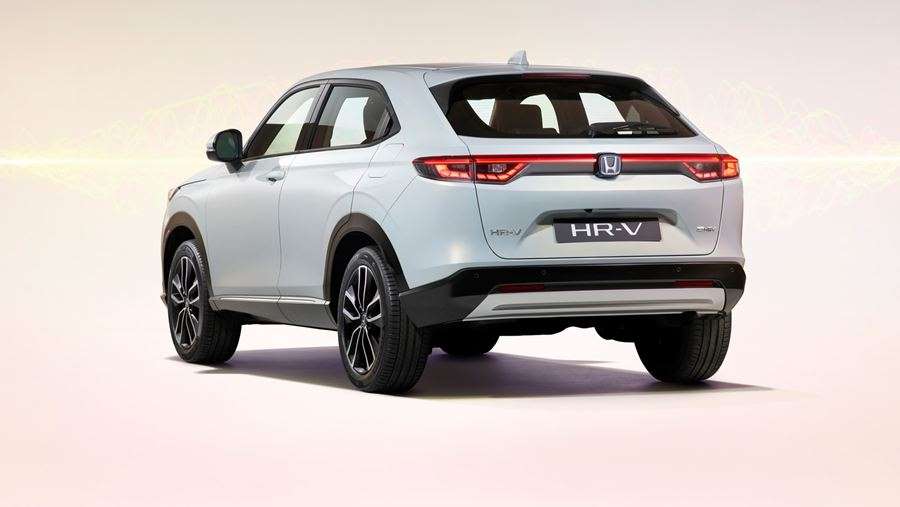
Honda discontinued its 1.6-litre diesel engine in 2020 amid freefalling diesel sales. The new HR-V is part of the brand’s ‘Electric Vision’ strategy, which aims to introduce hybrid or electric power to all of its mainstream models by 2022.
Design
The new HR-V has a rakish design thanks to a coupe-inspired swooping roofline and a longer bonnet. Despite the sporty profile of the roof, which is 20mm lower than the old car, Honda claims the new HR-V can accommodate four adults in comfort thanks to improved packaging of the hybrid powertrain which results in an extra 35mm of rear legroom.
The front features a new integrated grille and slim LED headlights joined together by a narrow piece of chrome trim. The new HR-V also sits 10mm higher than before, with the sides of the car featuring black plastic body cladding around the arches and sills, together with a high indent line along the length of the car and a flush-fitting rear door handle. Large 18-inch five-spoke two-tone alloy wheels also feature.
The rearmost C-pillar is more sharply angled than before, leading to a new tailgate that houses a slim rear tail light cluster that wraps round from the rear quarter panel across the width of the car.
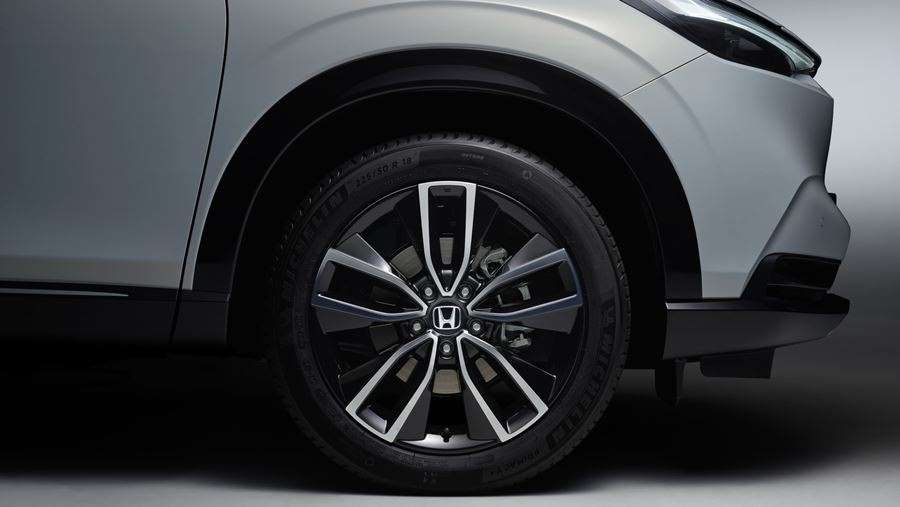
Interior and technology
Inside, the dashboard has been redesigned with a new minimalist look. A nine-inch central infotainment touchscreen is mounted to the top of the dashboard, which appears to be running similar software to the system used in the Honda e, which includes sat nav and smartphone connectivity.
Honda has retained physical rotary dials for the climate controls in a wrap-around centre console with a refreshed gear stick design. The clean dashboard design features an ‘Air Diffusion System’ that replaces the traditional air vents in the centre of the dashboard. This comprises two L-shaped vents mounted by the windscreen pillars, which direct air along the inside the windows to adjust the interior temperature - all without blasting hot or cold air directly at the driver or passenger.
The brand’s versatile Magic Seats storage system also features, offering the option to fold the rear seats flat or to flip up the rear seat bases depending on the storage space required.
Full details of the new car’s interior tech and trim levels are expected to be announced later this year.
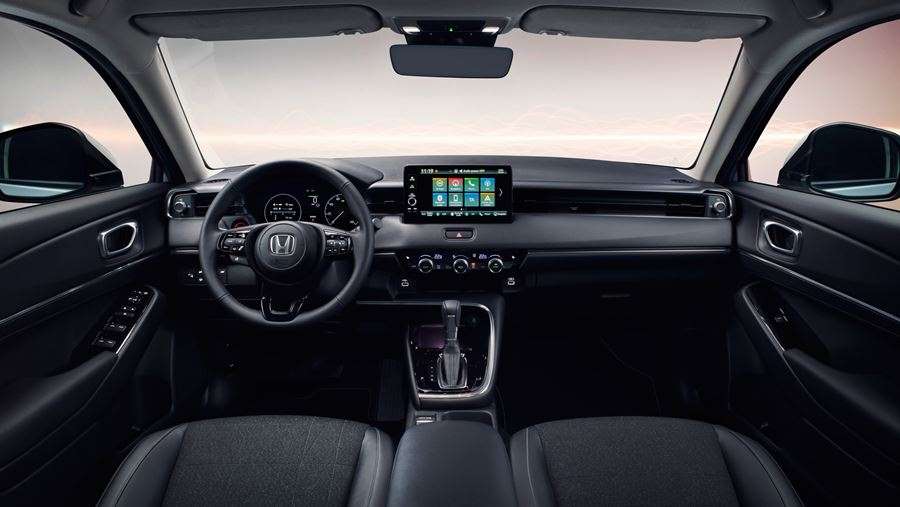
Safety
The new third-generation HR-V is fitted with Honda’s ‘Sensing’ safety suite adding an array of driver assistance technology. A new front camera is fitted, which has more processing power than before and improves both the car’s emergency braking and steering systems.
The new camera is able to better detect pedestrians detection, and is capable of recognising oncoming vehicles including cyclists and motorcycles, automatically applying the brakes when a hazard is detected.
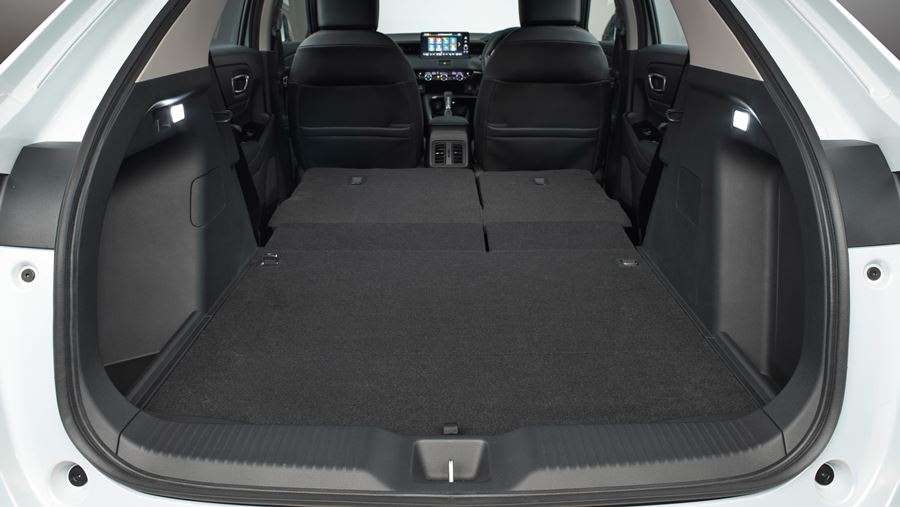
A new adaptive cruise control system is also included, with new advanced software meaning it can perform overtakes when prompted. The system can work out the acceleration and steering angles required to complete a passing maneuver, all with minimal input from the driver.
The new Opel Manta will have an unprecedented digital grille
A few months ago, Opel surprised us with the news that it was preparing a new edition of the legendary Manta A model, which was produced during the 1970s. As expected, the new Manta will have an electric heart, and now the German brand has surprised with a new, hitherto unseen detail - a digital front mask that will print text messages.
The new Opel Manta GSe is a real restomode, or in this case the electric model of the legendary model. As we wrote earlier, Manta Elektromod will remain a classic, but with a new drive. From the attached it can be seen that the design is quite retro. Legendary lines have been retained, as well as a lot of design solutions from the cult model, but the front and rear end have been modernized.
In addition to the striking neon yellow color, Manta also got a new digital face, ie in place of the former "grill" there will be a display that will use the most modern LED technology. It is a Pixel-Vizor design that includes the width of the front part of the vehicle, and with which the Manta will "communicate" with the environment.
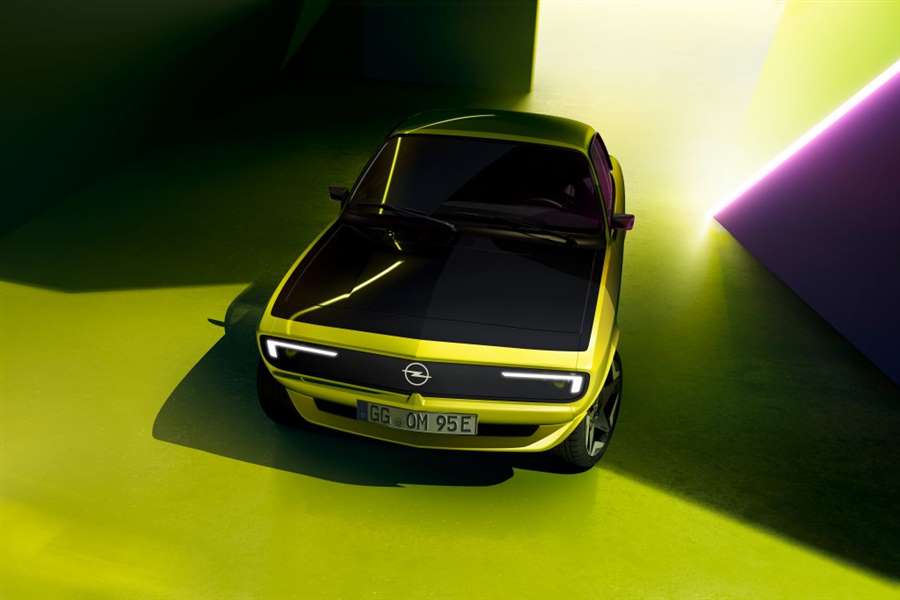
It will display various signs and messages, and some of them are: "My German heart is electrified", "I am on a zero e-mission", "I am ElektroMOD" and the like. The designers also prepared the cult Opel logo in the form of a QR code.
“The new Opel Manta has been designed by passionate designers, 3D modelers, engineers, technicians, mechanics and designers. And they are all real Opel fans, ”said Pierre-Olivier Garcia, the company's brand manager.
The fully electric Manta GSe Elektromod will have a digital, sports cockpit, and is currently in the final phase of development, while the premiere of the neo (n) -classic is scheduled for May 19 this year, when we will find out other details.
Recall that car manufacturers are increasingly looking for inspiration for new electric vehicles in the past, which is already clear from several examples: Renault with the new R5, Hyundai with 45, Peugeot with the e-Legend Concept, and so on. Now Opel is back in the seventies and has announced a real restomod.


